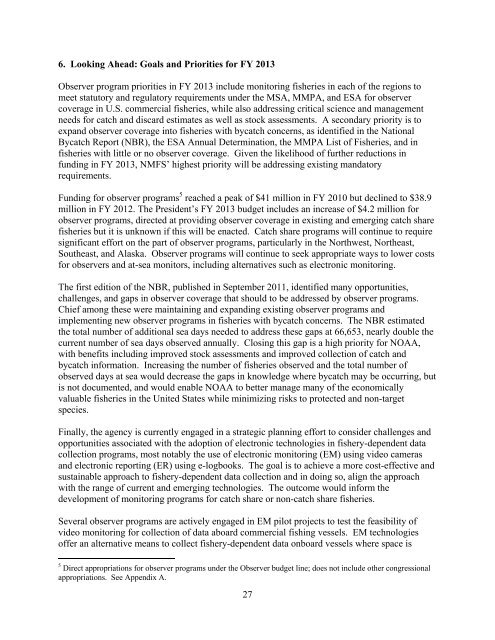National Observer Program Annual Report - Office of Science and ...
National Observer Program Annual Report - Office of Science and ...
National Observer Program Annual Report - Office of Science and ...
Create successful ePaper yourself
Turn your PDF publications into a flip-book with our unique Google optimized e-Paper software.
6. Looking Ahead: Goals <strong>and</strong> Priorities for FY 2013<br />
<strong>Observer</strong> program priorities in FY 2013 include monitoring fisheries in each <strong>of</strong> the regions to<br />
meet statutory <strong>and</strong> regulatory requirements under the MSA, MMPA, <strong>and</strong> ESA for observer<br />
coverage in U.S. commercial fisheries, while also addressing critical science <strong>and</strong> management<br />
needs for catch <strong>and</strong> discard estimates as well as stock assessments. A secondary priority is to<br />
exp<strong>and</strong> observer coverage into fisheries with bycatch concerns, as identified in the <strong>National</strong><br />
Bycatch <strong>Report</strong> (NBR), the ESA <strong>Annual</strong> Determination, the MMPA List <strong>of</strong> Fisheries, <strong>and</strong> in<br />
fisheries with little or no observer coverage. Given the likelihood <strong>of</strong> further reductions in<br />
funding in FY 2013, NMFS’ highest priority will be addressing existing m<strong>and</strong>atory<br />
requirements.<br />
Funding for observer programs 5 reached a peak <strong>of</strong> $41 million in FY 2010 but declined to $38.9<br />
million in FY 2012. The President’s FY 2013 budget includes an increase <strong>of</strong> $4.2 million for<br />
observer programs, directed at providing observer coverage in existing <strong>and</strong> emerging catch share<br />
fisheries but it is unknown if this will be enacted. Catch share programs will continue to require<br />
significant effort on the part <strong>of</strong> observer programs, particularly in the Northwest, Northeast,<br />
Southeast, <strong>and</strong> Alaska. <strong>Observer</strong> programs will continue to seek appropriate ways to lower costs<br />
for observers <strong>and</strong> at-sea monitors, including alternatives such as electronic monitoring.<br />
The first edition <strong>of</strong> the NBR, published in September 2011, identified many opportunities,<br />
challenges, <strong>and</strong> gaps in observer coverage that should to be addressed by observer programs.<br />
Chief among these were maintaining <strong>and</strong> exp<strong>and</strong>ing existing observer programs <strong>and</strong><br />
implementing new observer programs in fisheries with bycatch concerns. The NBR estimated<br />
the total number <strong>of</strong> additional sea days needed to address these gaps at 66,653, nearly double the<br />
current number <strong>of</strong> sea days observed annually. Closing this gap is a high priority for NOAA,<br />
with benefits including improved stock assessments <strong>and</strong> improved collection <strong>of</strong> catch <strong>and</strong><br />
bycatch information. Increasing the number <strong>of</strong> fisheries observed <strong>and</strong> the total number <strong>of</strong><br />
observed days at sea would decrease the gaps in knowledge where bycatch may be occurring, but<br />
is not documented, <strong>and</strong> would enable NOAA to better manage many <strong>of</strong> the economically<br />
valuable fisheries in the United States while minimizing risks to protected <strong>and</strong> non-target<br />
species.<br />
Finally, the agency is currently engaged in a strategic planning effort to consider challenges <strong>and</strong><br />
opportunities associated with the adoption <strong>of</strong> electronic technologies in fishery-dependent data<br />
collection programs, most notably the use <strong>of</strong> electronic monitoring (EM) using video cameras<br />
<strong>and</strong> electronic reporting (ER) using e-logbooks. The goal is to achieve a more cost-effective <strong>and</strong><br />
sustainable approach to fishery-dependent data collection <strong>and</strong> in doing so, align the approach<br />
with the range <strong>of</strong> current <strong>and</strong> emerging technologies. The outcome would inform the<br />
development <strong>of</strong> monitoring programs for catch share or non-catch share fisheries.<br />
Several observer programs are actively engaged in EM pilot projects to test the feasibility <strong>of</strong><br />
video monitoring for collection <strong>of</strong> data aboard commercial fishing vessels. EM technologies<br />
<strong>of</strong>fer an alternative means to collect fishery-dependent data onboard vessels where space is<br />
5 Direct appropriations for observer programs under the <strong>Observer</strong> budget line; does not include other congressional<br />
appropriations. See Appendix A.<br />
27

















